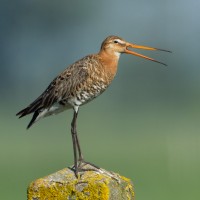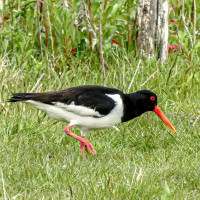Description
The Bay of Aytré is an interesting ornithological site, especially for shorebirds. Let's take a look at the mudflat: this large expanse of mud is a place of feeding and migratory staging for shorebirds. It is possible to observe very common species such as Ruddy Turnstone, Black-tailed Godwit or Sanderling, but also somewhat less common species such as Ruff or Purple Sandpiper. You can also easily observe Dunlin, Eurasian Curlew and Whimbrel, Eurasian Oystercatcher, Grey Plover, Common Ringed Plover, Black-tailed Godwit and Bar-tailed Godwit pecking in the mud. In Winter, the Brent Goose, Greylag Goose and Common Shelduck will also probably be present. It will also be possible to meet some Northern Shoveler, Eurasian Wigeon and Northern Pintail feeding in the few remaining puddles during the upstream ocean.
Let's move on to the marshes: From here you will be able to observe some species quite different from those present on the mudflat. The Common Sandpiper, Green Sandpiper, Common Greenshank and Common Redshank will be present. The Mute Swan also. But it is the Zitting Cisticola who will push their melodies during the afternoon. The Great Cormorant will dry their wings on the electric pylons, while the discreet Purple Heron will survey the ground with the Grey Heron and Little Egret. It is possible to observe some Cattle Egret in the middle of a herd of cows or horses. In winter, the Great Egret will also be present, in the middle of Brent Goose and ducks.
Passing through the Pointe du Chay, the Northern Gannet will be observable, with some European Herring Gull, Yellow-legged Gull, Common Gull, Lesser Black-backed Gull, , Sandwich Tern and Mediterranean Gull. The lucky ones may be able to observe a small group of Common Guillemot passing close to the waves, or even a few Balearic Shearwater in flight in the distance.
NB: a resting place for shorebirds and gulls at high tide is at GPS coordinates (46.110067, -1.129795). It is best to come 2 hours before high tide to be able to observe the birds arriving in small groups.
_________________________
Français: Entre plage, vasière, galets, marais et dunes, la baie d'Aytré est un site très intéressant l'ornithologie, de part sa diversité que sa quantité. Et notamment pour les Limicoles. Intéressons nous à la vasière : cette grande étendue de vase est un lieu de nourrissage et de pose migratoire pour les Limicoles. Il est possible d'observer des espèces très communes comme le Ruddy Turnstone , Black-tailed Godwit ou encore le Sanderling , mais aussi des espèces un peu moins communes comme le Ruff ou le Purple Sandpiper . Vous pourrez aussi facilement observer les Dunlin , les Eurasian Curlew et les Whimbrel , les Eurasian Oystercatcher , les Grey Plover, , les Common Ringed Plover , les Black-tailed Godwit et les Bar-tailed Godwit se nourrisants à coup de bec dans la vase. En Hiver, les Brent Goose , les Greylag Goose et les Common Shelduck seront aussi probablement présentent. Il sera aussi possible de croiser quelques Northern Shoveler , Eurasian Wigeon et Northern Pintail se nourrissant dans les quelques flaques restantes lors de la remontée de l'océan...
Passons ensuite aux marais : D'ici, vous pourrez observer quelques espèces assez différentes de celles présentent sur la vasière... Les Common Sandpiper , Green Sandpiper , Common Greenshank et Common Redshank seront présents. Les Mute Swan se présenteront aussi. Mais c'est plutôt les Zitting Cisticola qui pousseront leurs mélodies durant l'après midi. Les Great Cormorant se secheront les ailes sur les pylônes électrique, tandis que le discret Purple Heron arpentera le sol avec les Grey Heron et les Little Egret . Il est possible d'observer quelques Cattle Egret au milieu d'un troupeau de vaches ou de chevaux. En hiver, les Great Egret seront tout aussi présentent, au milieu des Brent Goose et des Anatidés...
En passant par la pointe du Chay, les Northern Gannet seront observables, avec quelques European Herring Gull , Yellow-legged Gull , Common Gull , Lesser Black-backed Gull , Great Black-backed Gull , Sandwich Tern et Mediterranean Gull . Les plus chanceux pourront peut être observer un petit groupe de Common Guillemot passant au ras des vagues, ou encore quelques Balearic Shearwater en vol au loin.
Bonnes obs!
NB: un reposoir de Limicoles et de Laridés à marée haute est au coordonnées GPS (46.110067,-1.129795). Le mieux est de venir 2 heures avant la pleine mer pour pouvoir observer les oiseaux arriver par petits groupes.
Details
Access
It is possible to visit this site on foot or by bicycle. Several free car parks are available.
_________________________
Français: Il est possible de visiter ce site à pied ou à vélo. Plusieurs parkings gratuits sont à disposition.

